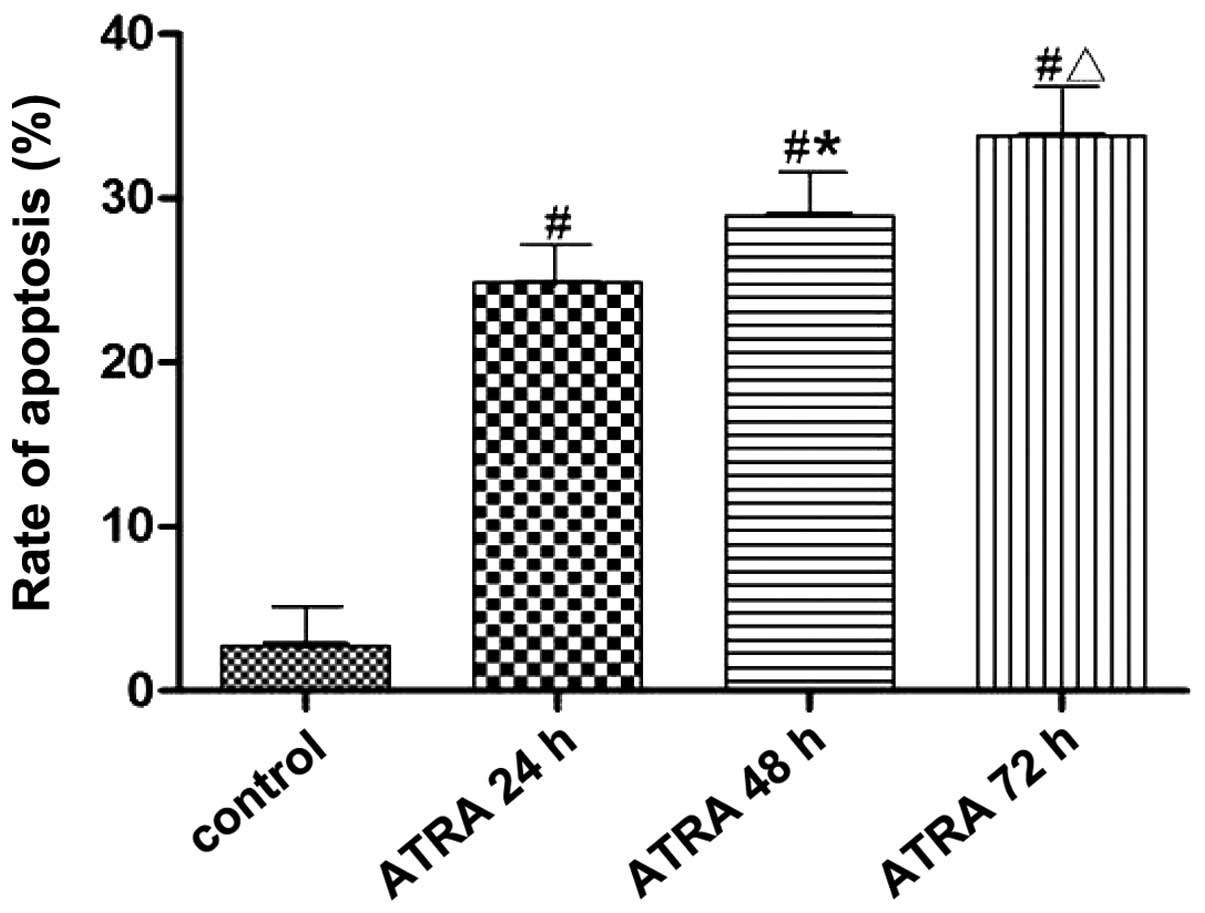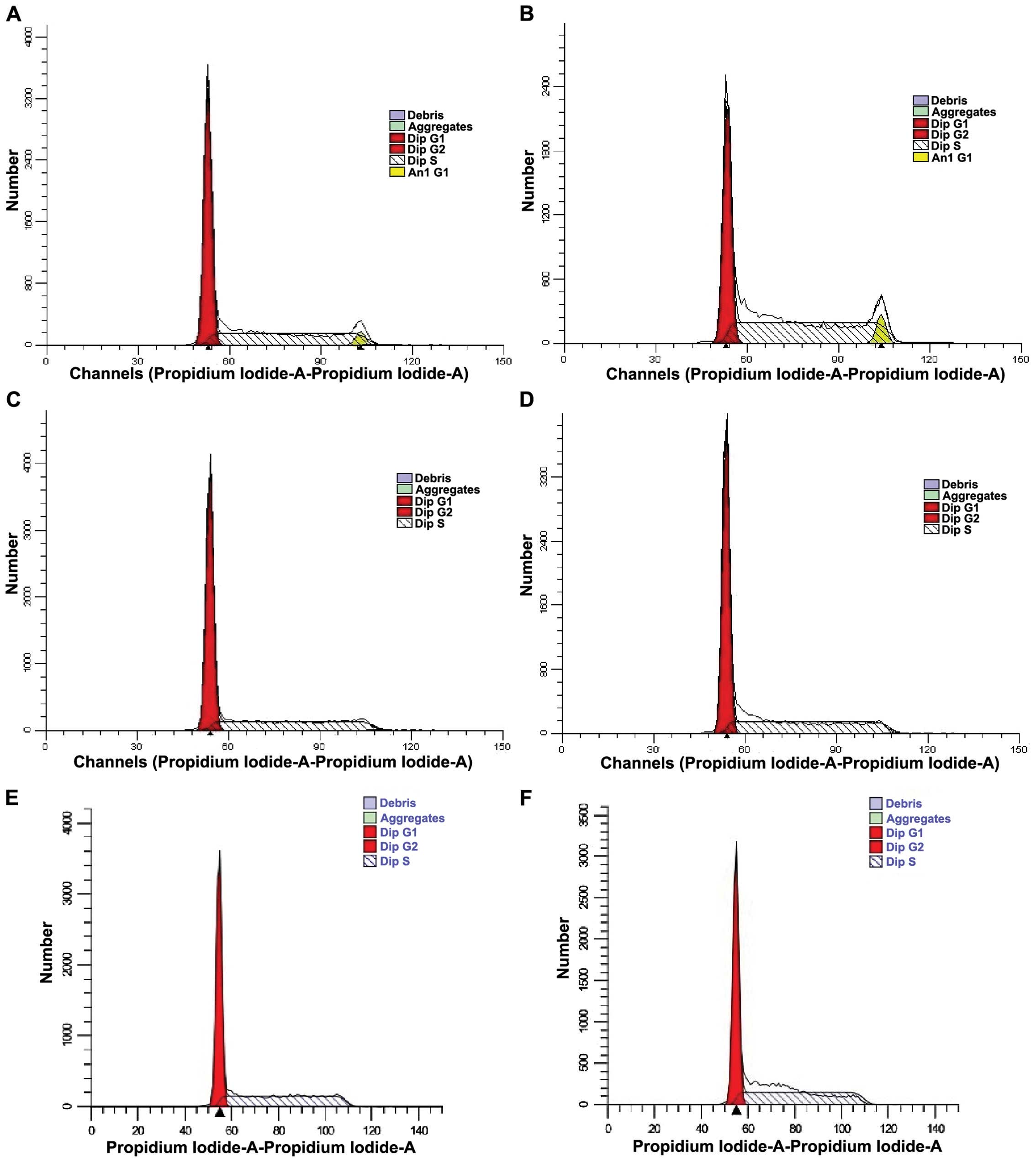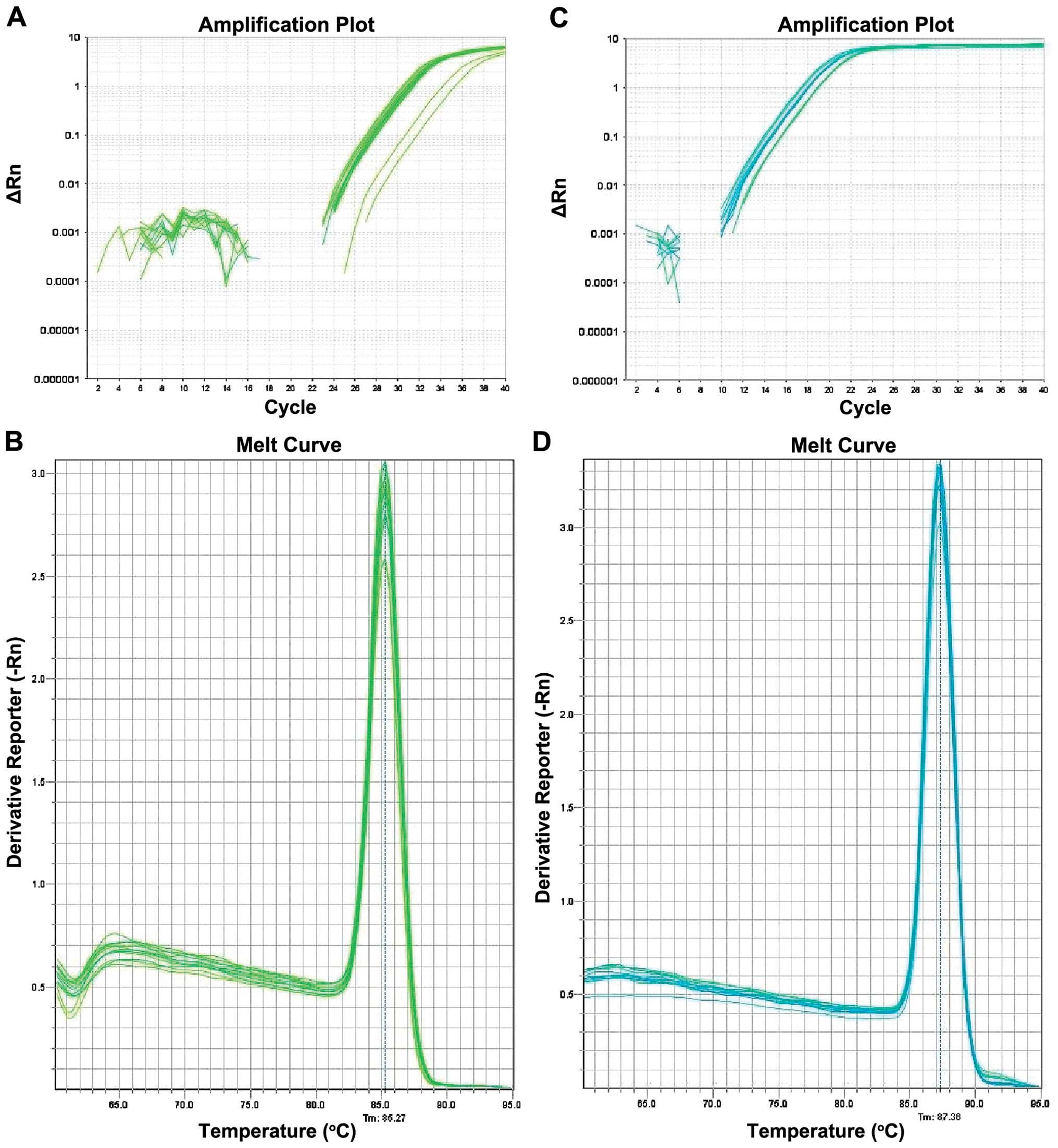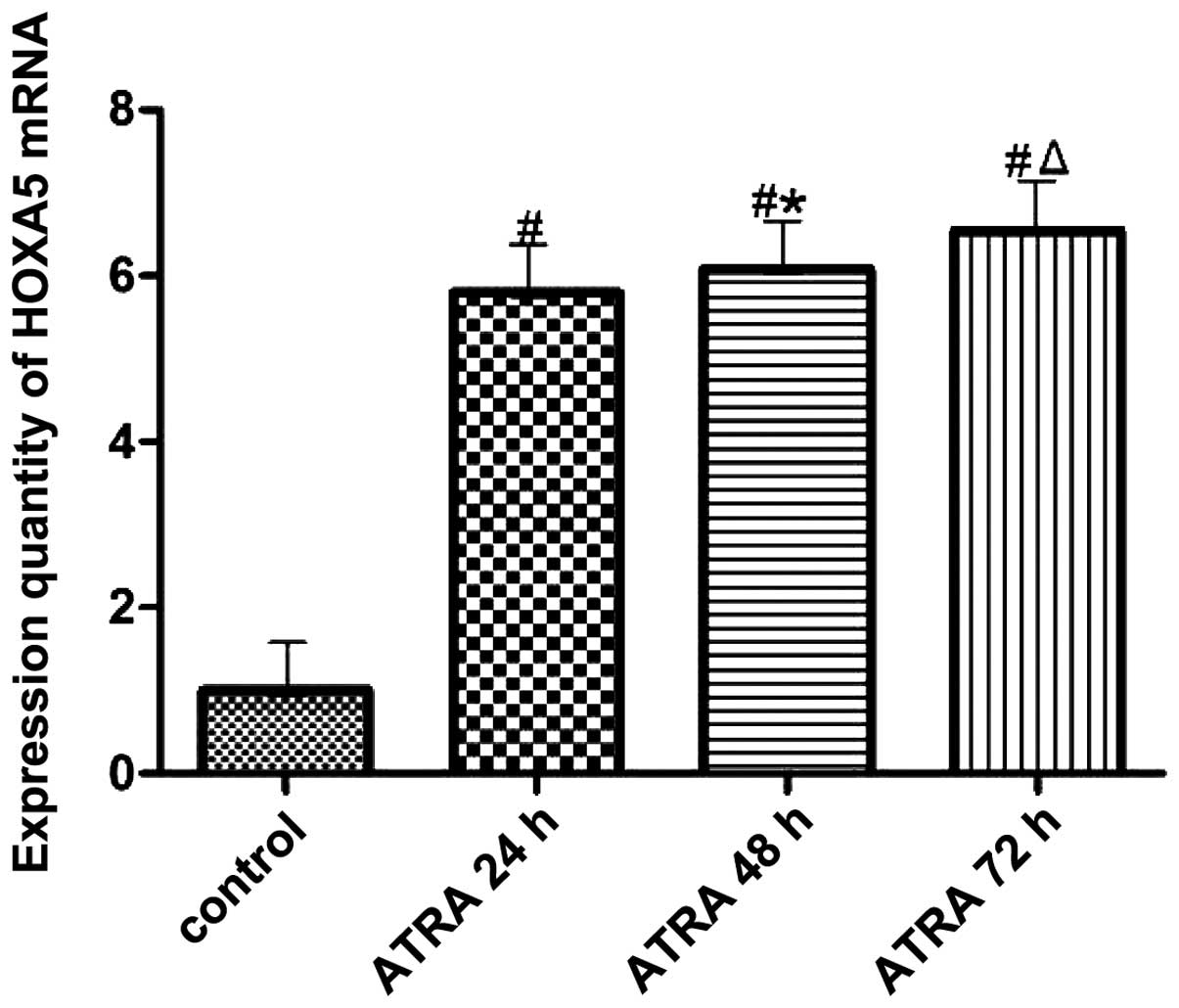Effect of ATRA on the expression of HOXA5 gene in K562 cells and its relationship with cell cycle and apoptosis
- Authors:
- Published online on: April 4, 2016 https://doi.org/10.3892/mmr.2016.5086
- Pages: 4221-4228
-
Copyright: © Liu et al. This is an open access article distributed under the terms of Creative Commons Attribution License.
Abstract
Introduction
Acute lymphoblastic leukemia (ALL) is a neoplastic disease originating from B- or T-lymphocytes (1–2), and accounts for 80% of childhood acute leukemia (AL) and is the most common type of cancer affecting children (3,4). The incidence rate of ALL is 5-fold higher than that of acute myeloid leukemia (AML) (3). The ALL prognosis has improved greatly. However, only 80–90% of the children achieve complete remission (5,6), whereas 20% of children with leukemia suffer ALL relapse and subsequently have a poor prognosis (3,6).
Homeobox (HOX) is a highly conserved family of genes that controls embryonic development and cell differentiation. Abnormal regulation thereof is associated with the occurrence of malignant tumors (7). HOX is divided into the A, B, C, and D genetic clusters, which are located on chromosomes, HOXA (7p15), HOXB (17q21), HOXC (12q13) and HOXD (2q31) (8).
Differentiation of abnormal hematopoietic stem/progenitor cells (HSPC) regulated by HOX is associated with the occurrence and development of leukemia (9–11). The differentiation and development of HSPC was regulated by HOXA5 at the pluripotent stem cell stage during differentiation and development from erythroid to granulocyte cells (12). Kim et al (13) showed that the amount of HOXA5 methylation level is associated with the 3-year survival rate of AML patients. Inhibition of the expression of HOXA5 gene in bone marrow hematopoietic cells by the antisense oligonucleotide technique showed that myeloid progenitor cell growth was inhibited, while the proliferation of erythroid progenitor cells was accelerated. When the HOXA5 gene was overexpressed, the proliferation and differentiation of K562 cells into erythroid cells was inhibited (14). The abovementioned studies suggested that HOXA5 is associated with the development of leukemia. All-trans retinoic acid (ATRA) exerts antitumor effects by inducing the differentiation of tumor cells, promoting tumor cell apoptosis and regulating cell tumor-related gene and protein expression (15,16). Previous studies have confirmed that ATRA is capable of regulating the expression of certain HOX genes in hematopoietic cells, such as HOXB2, HOXB4 and HOXA10, which provides a new research direction for ATRA in the treatment of leukemia (17–19).
The aim of the present study was to investigate the changes in the expression of HOXA5 gene and its relationship with the cell cycle and apoptosis through the intervention of the human K562 myeloid leukemia cell line using ATRA, in order to analyze the role HOXA5 plays on the pathogenesis and the development process of myeloid leukemia.
Materials and methods
Cell line
K562 cells were provided by the Central Laboratory of the Affiliated Hospital of Luzhou Medical College (Luzhou, China).
Reagents and instruments
Reagents and equipment used were as follows: Total RNA extraction kit [Tiangen Biotech (Beijing) Co., Ltd., Beijing, China]; iScript cDNA synthesis kit, C1000 polymerase chain reaction (PCR) amplification, protein electrophoresis (Bio-Rad, Berkeley, CA, USA); cell counting kit-8 (CCK-8) kit (Beyotime Biotechnology Research Institute, Jiangsu, China); ATRA (Sigma, St. Louis, MO, USA); fetal bovine serum (Hyclone, Logan, UT, USA); flow cytometry apoptosis kit box, cell cycle kit, flow cytometry (BD Biosciences, Franklin Lakes, NJ, USA); western blotting primary antibody (Abcam, Cambridge, UK); western blotting secondary antibody (Beyotime Biotechnology Research Institute); HOXA5 and GAPDH primers (Sangon Biotech Co., Ltd., Shanghai, China); cell culture box (NuAire US Autoflow, Plymouth, MN, USA); high speed centrifuge (Beckman Coulter, Athens, Greece); and clean bench (Suzhou Antai Air Tech Co., Ltd., Suzhou, China).
Cell proliferation and toxicity test (CCK-8)
According to the incubation time, the cells were divided into the negative control group (K562 cells and culture medium without ATRA intervention) and four experimental groups (i.e., ATRA 24 h, 48 h, 72 h and 96 h groups). A blank group, i.e., culture medium without K562 cells was also established as a control. The ATRA concentrations used were, 5.0, 7.5, 10.0 and 15.0, and 20.0 µmol/l, respectively, in accordance with the CCK-8 kit instructions. Optical density (OD) values were measured at 450 nm. The experiment was repeated three times. The mean value was calculated for the cell proliferation inhibition rate as: (OD of control group − OD of experimental group)/(OD of control group − OD of blank group) × 100%.
Experimental group
The experiment was divided into the control and experimental groups. The cells in the experimental group were treated with 10 µmol/l ATRA for 24, 48 and 72 h, respectively.
Detection of K562 cell apoptosis
To detect cell apoptosis, the cells were washed with phosphate-buffered saline and suspended in binding buffer, followed by the addition of annexin V-fluorescein isothiocyanate and propidium iodide. After 15 min at room temperature (25°C) in the dark, the apoptotic rate was measured using flow cytometry within 1 h.
Detection of K562 cell cycle
To determine the cell cycle, the cells were suspended in buffer solution followed by the addition of solution A and incubation for 10 min. Solution B was added and incubated for 10 min at room temperature. Solution C was subsequently added and kept at 2–8°C for 10 min in the dark. The cell cycle was then determined using flow cytometry.
Quantitative PCR for the determination of HOXA5 mRNA expression
Total RNA was extracted from K562 cells using a total RNA extraction kit. The concentration and purity (OD260/OD280) were determined. The total RNA was reverse transcribed into cDNA on a PCR instrument using an iScript cDNA kit. HOXA5 gene cDNA was added into the reaction system on ABI RT-PCR according to the manufacturer protocols. HOXA5 and GAPDH primer sequences are shown in Table I. Cycle threshold (Ct) values obtained were analyzed by Step One software (Applied Biosystems, Foster City, CA, USA). Sample Ct value and target gene relative expression were also calculated (2−ΔΔCt).
Expression of HOXA5 protein in K562 cells
Cells were collected from the experimental and control groups and were processed using SDS-PAGE and western blot analysis, and the protein bands were subsequently scanned and quantified. The primary antibody was rabbit anti-human HOXA5 polyclonal antibody, and the secondary antibody was goat anti-rabbit immunoglobulin G conjugated with horseradish peroxidase. Subsequently, the protein bands of HOXA5 were analyzed.
The internal reference gene was β-actin (Beyotime Biotechnology Research Institute). The relative ratio of the target protein was determined using HOXA5 protein bands of gray value and β-actin protein bands of gray value. The gray level ratio with HOXA5 and the internal reference gene β-actin, as well as the relative expression quantity of HOXA5 protein expressed in the experimental group was carried out. Subsequently, the protein bands of HOXA5 were analyzed.
Statistical analysis
Data were analyzed using SPSS 17.0 software (SPSS, Inc., Chicago, IL, USA). Data were presented as mean ± standard deviation. A comparison between groups was analyzed by single-factor variance analysis. Pair-wise comparisons used least significant difference. P<0.05 was considered to indicate a statistically significant difference. The correlation analysis between two variables was analyzed using the Spearman rank correlation analysis, and a=0.05 was a significant test level.
Results
Effect of ATRA intervention on K562 cell proliferation inhibition
Table II shows the cell proliferation and cell viability in each group. The results showed that, the OD value was decreased with the increase in the concentration of ATRA (P<0.05). At the same concentration of ATRA, with the extension of incubation time, OD value increased gradually. The differences between groups were also statistically significant (P<0.05).
Table IICell viability of K562 determined by ATRA on different concentration (OD=450 nm, mean ± SD). |
Fig. 1 shows the inhibition of K562 cell proliferation as a percentage change. The proliferation of the K562 cell inhibition rate was lower when the ATRA concentrations were 5.0 and 7.5 µmol/l. The result indicated that the inhibitory effect of the drug on the cells was weaker. When the concentration of ATRA was 15.0 and 20.0 µmol/l, the proliferation of the K562 cell inhibitory rate was markedly higher, indicating that the inhibitory effects of drug on cells were strong with strong cytotoxicity. The concentration of ATRA at 10 µmol/l was optimal when the proliferation inhibitory rate was ~50%, and at this ATRA concentration it was easy to detect the HOXA gene and protein expression. Thus, 10 µmol/l of ATRA was used in the subsequent experiments.
Effect of ATRA on apoptosis of K562 cells
Determination of K562 cell apoptotic rates using flow cytometry (Fig. 2). LL in the lower left quadrant is indicated living cells. LR in the right lower quadrant indicated early apoptotic cells. UR in the right upper quadrant represented the late apoptotic cells with UL in the left upper quadrant of the mechanically damaged cells. The ratio of the number of cells in the UR and LR quadrants and the total cell number constituted the apoptotic rate.
Data of the cell apoptotic rate in each group was measured using flow cytometry and analyzed using SPSS 17.0 software (Fig. 3). The apoptotic rates of K562 cells were 24.84±0.14, 28.90±0.30 and 33.44±0.48% after 10.0 µmol/l ATRA intervention for 24, 48 and 72 h, respectively, which was significantly higher than that in the control group (P<0.05). The apoptotic rate was increased gradually with the prolongation of ATRA intervention (P<0.05).
Analysis of K562 cell cycle using flow cytometry
Cell cycle was determined by flow cytometry (Fig. 4). ModFit software (Verity Software House, Topsham, ME, USA) was used to calculate the proportion of cell cycle at each time point (Table III). The data showed that the proportion of G0/G1 phase was increased and the proportion of S stage was reduced in the drug-treated group compared to those in the control group at each time point, indicating that cell proliferation and cell cycle were inhibited in the G0/G1 phase.
Effect of ATRA intervention for 24, 48 and 72 h on the expression of HOXA5 mRNA
Amplification and dissolution curve in the experiment. HOXA5 gene and its reference GAPDH amplification curve are S-type kinetic curves (Fig. 5). HOXA5 and GAPDH melting curves were obtained following PCR reaction, which is a single absorption peak with the single solution temperature, 85.3 and 87.4°C, respectively. This result indicated that the primers were specific. Results of the agarose gel electrophoresis for the RT-PCR amplification products of HOXA5 gene and GAPDH in K562 cells are shown in Fig. 6. The bands are clearly shown with no impurities, suggesting that the RT-PCR amplification was successful.
Expression of HOXA5 mRNA in K562 cells detected by RT-PCR
The amount of HOXA5 mRNA expression is shown in Fig. 7. It is evident that HOXA5 mRNA expression in the experimental group increased compared with that in the control group. The difference was statistically significant (P<0.05). With the prolonged intervention time, HOXA5 mRNA expression increased gradually (Fig. 7). The difference was statistically significant (P<0.05).
Expression of HOXA5 protein detected by western blotting
The electrophoresis of HOXA5 protein and β-actin are shown in Fig. 8. Each of the electrophoretic bands is clear, and HOXA5 protein expression was increased in the experimental group compared with that of the control group, and with prolonged intervention time, the HOXA5 expression increased gradually.
Expression of HOXA5 protein following ATRA intervention in K562 cells
Fig. 9 shows that HOXA5 protein expression was increased in the experimental group compared with that of the control group. The difference was statistically significant (P<0.05). With prolonged intervention time, HOXA5 expression increased gradually. The difference was statistically significant (P<0.05).
HOXA5 mRNA and protein expression changes its relationship with cell apoptosis after ATRA intervention of K562 cells
The mRNA HOXA5 and protein expression and cell apoptotic rate were increased 24, 48 and 72 h after ATRA intervention in the experimental group compared with that of the control group (Table IV).
Table IVThe relationship between cell apoptosis and HOXA5 mRNA and protein expression changes (mean ± SD). |
Spearman rank correlation analysis revealed that the correlation coefficient rate of HOXA5 mRNA expression and cell apoptosis was 0.944, which was positively correlated (P<0.05). The correlation coefficient for the relationship between HOXA5 protein expression and the apoptotic rate was 0.826 (P<0.05). Thus, ATRA may promote K562 cell apoptosis by upregulating the expression of HOXA5.
HOXA5 mRNA and protein expression changes in K562 cells after ATRA intervention
Following treatment with ATRA the ratio of cells in the G0/G1 phase were higher and the ratio of cells in S stage was lower in the intervention group compared with that of the control group (Table III).
Accordingly, the G0/G1 phase increased percentage was calculated as (experiment group-control group)/control group) and S stage reduction percentage as (control group-experimental group/control group) (Table V).
The Spearman rank correlation analysis revealed that the correlation coefficient of the amount of HOXA5 mRNA expression and the increased percentage of cells in G0/G1 was 1.00, which was positively correlated. Its correlation coefficient with the S phase decreased percentage was −1.00, indicating a negative correlation. The correlation coefficient of HOXA5 protein expression and increased percentage of the cell cycle in G0/G1 phase was 1.00, which was positively correlated. The correlation coefficient with the S phase decreased percentage was −1.00, indicating a negative correlation. These data suggested that ATRA may increase mRNA HOXA5 and protein expression in the G0/G1 phase, decreasing the proportion of S stage and inhibiting cell proliferation.
Discussion
Leukemia is a hematopoietic system malignant proliferative disease, whose incidence is on the increase. It is the most common malignant tumor for children, accounting for approximately 33% of children with malignant tumors (12). It is a serious threat to the health of children and adolescents. The pathogenesis of leukemia is unclear at present. HOXA is the master control gene for HSPC proliferation and differentiation, and the abnormal expression of is closely associated with the disease of blood system (20–22).
Guo and Liu (23) identified that HOXA9 is expressed in HL-60 cells, and HOXA9 mRNA and protein expression level changes in HL-60 cells following treatment with ATRA. Zhang and Liu (24) showed HOXB7 mRNA and protein expression in human umbilical cord blood stem cells by RT-PCR and western blot analysis. In addition, authors of that study showed that HOXB7 mRNA and protein expression increased after ATRA intervention, suggesting that ATRA regulates the expression of Hox genes affecting the hematopoietic cells.
In the present study, RT-PCR and western blot analysis revealed that in the process of K562 cell proliferation, HOXA5 mRNA and protein expression was detected. HOXA5 mRNA and protein expression was elevated following ATRA intervention of K562 cells for 24, 48 and 72 h. With the intervention time prolonged, HOXA5 mRNA and protein expression levels increased gradually. The results indicate that HOXA5 mRNA and protein expression increased in K562 cells following treatment with ATRA in a time-dependent manner, which is similar to other reports on Hox gene expression (23).
ATRA is an effective cell apoptosis-inducing agent that promotes tumor cell apoptosis. Zhu et al (25) demonstrated that the rate of apoptosis of the pancreatic cancer cell lines were significantly higher than those in the control group following ATRA intervention of the human SW1990, Patu8988, bxpc3 pancreatic cancer cell lines, as detected by flow cytometry. Additionally, the apoptotic rate increased with longer treatment time. The experimental study also showed that the cell apoptotic rate increased following the intervention with 10 µmol/l ATRA for the human K562 myeloid leukemia cell line. With the increase in the time of intervention, the apoptotic rate increased gradually, as indicated in the above-mentioned results. Numerous chemotherapeutic agents are able to interfere with the cell cycle by blocking it. Inui et al (26) demonstrated that ATRA was able to change the cell cycle and signal transduction pathway by affecting the synthesis of DNA, and confine the cell cycle to a certain period of stagnation through investigation. Zhou et al (27) identified that A549 cell proliferation was inhibited, and the cell cycle was arrested in G1/G0 phase following ATRA intervention detected by flow cytometry. The results in the present study have shown that the proportion of the cell cycle in the G0/G1 phase increased after 10.0 µmol/l ATRA intervention of K562 cells for 24, 48 and 72 h. The cell proportion in S stage was reduced. The cell cycle was arrested in the G0/G1 phase and cell proliferation was inhibited, similar to the abovementioned results.
In addition, data pertaining to HOXA5 mRNA and protein expression, the cell apoptotic rate and cell cycle changes were analyzed using the Spearman correlation analysis. Our results that HOXA5 mRNA and protein expression and cell apoptosis were positively associated. It also positively correlated with the increased percentages of the cell cycle in G0/G1 phase, but negatively correlated with the reduction percentage of S phase, suggesting that ATRA inhibits K562 cell proliferation and induces cell apoptosis through the upregulation of HOXA5 mRNA and protein expression. The etiology and pathogenesis of childhood leukemia have yet to be determined. Abnormally expressed HOX gene may regulate the proliferation and differentiation of hematopoietic stem cells.
References
|
Huang Z, Liu WJ, Guo QL and Liu CY: Platelet parameter and platelet membrane glycoprotein in childhood acute lymphoblastic leukemia. Genet Mol Res. 14:16074–16089. 2015. View Article : Google Scholar : PubMed/NCBI | |
|
Xu Q and Liu W-J: Platelet changes in acute leukemia. Cell Biochem Biophys. 67:1473–1479. 2013. View Article : Google Scholar | |
|
Huang HP, Liu WJ, Guo QL and Ba YQ: Effect of silencing HOXA5 gene expression using RNA interference on cell cycle and apoptosis in Jurkat cells. Int J Mol Med. 37:669–678. 2016.PubMed/NCBI | |
|
Wessler JM: Leukemia in children: Getting back to school-part 1. NASN Sch Nurse. 30:116–118. 2015. View Article : Google Scholar : PubMed/NCBI | |
|
Annesley CE and Brown P: Novel agents for the treatment of childhood acute leukemia. Ther Adv Hematol. 6:61–79. 2015. View Article : Google Scholar : PubMed/NCBI | |
|
Lohi O, Kanerva J, Taskinen M, Harila-Saari A, Rounioja S, Jahnukainen K, Lähteenmäki P and Vettenranta K: Childhood leukemia. Duodecim. 129:939–946. 2013. | |
|
Liu WJ, Huang MX, Guo QL, Chen JH and Shi H: Effect of human cytomegalovirus infection on the expression of Hoxb2 and Hoxb4 genes in the developmental process of cord blood erythroid progenitors. Mol Med Rep. 4:1307–1311. 2011.PubMed/NCBI | |
|
Delval S, Taminiau A, Lamy J, Lallemand C, Gilles C, Noël A and Rezsohazy R: The Pbx interaction motif of Hoxa1 is essential for its oncogenic activity. PLoS One. 6:e252472011. View Article : Google Scholar : PubMed/NCBI | |
|
Jiang N and Liu W: Role of HOX gene in occurrence of leukemia and study progress. J Appl Clin Pediatr. 27:215–217. 2012. | |
|
Alharbi RA, Pettengell R, Pandha HS and Morgan R: The role of HOX genes in normal hematopoiesis and acute leukemia. Leukemia. 27:1000–1008. 2013. View Article : Google Scholar | |
|
Ding X, Yang Z, Zhou F, Wang F, Li X, Chen C, Li X, Hu X, Xiang S and Zhang J: Transcription factor AP-2α regulates acute myeloid leukemia cell proliferation by influencing Hoxa gene expression. Int J Biochem Cell Biol. 45:1647–1656. 2013. View Article : Google Scholar : PubMed/NCBI | |
|
Huang MX and Liu WJ: Effect of cluster a in Hox gene on proliferation and differentiation of hematopoietic stem/progenitor cells and its relation to leukemia - review. J Exp Hematol. 17:835–839. 2009. | |
|
Kim SY, Hwang SH, Song EJ, Shin HJ, Jung JS and Lee EY: Level of HOXA5 hypermethylation in acute myeloid leukemia is associated with short-term outcome. Korean J Lab Med. 30:469–473. 2010. View Article : Google Scholar : PubMed/NCBI | |
|
Bach C, Buhl S, Mueller D, García-Cuéllar MP, Maethner E and Slany RK: Leukemogenic transformation by HOXA cluster genes. Blood. 115:2910–2918. 2010. View Article : Google Scholar : PubMed/NCBI | |
|
Estey E, Garcia-Manero G, Ferrajoli A, Faderl S, Verstovsek S, Jones D and Kantarjian H: Use of all-trans retinoic acid plus arsenic trioxide as an alternative to chemotherapy in untreated acute promyelocytic leukemia. Blood. 107:3469–3473. 2006. View Article : Google Scholar | |
|
Liu WJ, Jiang NJ, Guo QL and Xu Q: ATRA and As2O3 regulate differentiation of human hematopoietic stem cells into granulocyte progenitor via alteration of HoxB8 expression. Eur Rev Med Pharmacol Sci. 19:1055–1062. 2015. | |
|
Chen S, Fang Y, Ma L, Liu S and Li X: Realgar-induced apoptosis and differentiation in all-trans retinoic acid (ATRA)-sensitive NB4 and ATRA-resistant MR2 cells. Int J Oncol. 40:1089–1096. 2012. | |
|
Liu WJ, Guo QL, Chen HY, Zou Y and Huang MX: Studies on HOXB4 expression during differentiation of human cytomegalovirus-infected hematopoietic stem cells into lymphocyte and erythrocyte progenitor cells. Cell Biochem Biophys. 63:133–141. 2012. View Article : Google Scholar | |
|
Chen JH, Liu WJ, Guo QL, Yang M, Jing QF and Huang MX: Umbilical cord blood hematopoietic stem progenitor cell proliferation in the process of human cytomegalovirus infection on HOXA9 and HOXA10 gene expression. Chin J Pract Pediatr. 25:607–610. 2010. | |
|
Kurscheid S, Bady P, Sciuscio D, Samarzija I, Shay T, Vassallo I, Criekinge WV, Daniel RT, van den Bent MJ, Marosi C, et al: Chromosome 7 gain and DNA hypermethylation at the HOXA10 locus are associated with expression of a stem cell related HOX-signature in glioblastoma. Genome Biol. 16:16–23. 2015. View Article : Google Scholar : PubMed/NCBI | |
|
Musialik E, Bujko M, Kober P, Grygorowicz MA, Libura M, Przestrzelska M, Juszczyński P, Borg K, Florek I, Jakóbczyk M, et al: Promoter DNA methylation and expression levels of HOXA4, HOXA5 and MEIS1 in acute myeloid leukemia. Mol Med Rep. 11:3948–3954. 2015.PubMed/NCBI | |
|
Jiang Q and Liu WJ: Relationship between the HOX gene family and the acute myeloid leukemia-review. Zhongguo Shi Yan Xue Ye Xue Za Zhi. 21:1340–1344. 2013.In Chinese. PubMed/NCBI | |
|
Guo WW and Liu WJ: Expression of homeobox A9 in myeloid leukemia cell line HL-60 and effect of drugs on its expression. J Exp Hematol. 20:300–304. 2012.In Chinese. | |
|
Zhang JX and Liu WJ: Expression and intervention of B7 in the development process of cord blood progenitor cells of myeloid progenitor cells. Practical J Pediatr. 26:1181–1184. 2011. | |
|
Zhu Y, Xia L, Zhang Y, Zhang X and Yuan Y: All trans retinoic acid on a variety of pancreatic cancer cell induced apoptosis. Chin J Pancreatol. 7:24–27. 2007. | |
|
Inui N, Sasaki S, Suda T, Chida K and Nakamura H: The loss of retinoic acid receptor alpha, beta and alcohol dehydrogenase3 expression in non-small cell lung cancer. Respirology. 8:302–309. 2003. View Article : Google Scholar : PubMed/NCBI | |
|
Zhou RJ, Liaow EG, Yang ZZ, Min JX and Xiao YB: Effects and mechanisms of ATRA on proliferation, cell cycle of lung carcinoma cell line A549. Di 3 Jun Yi Da Xue Xue Bao. 29:1399–1401. 2007.In Chinese. |


















